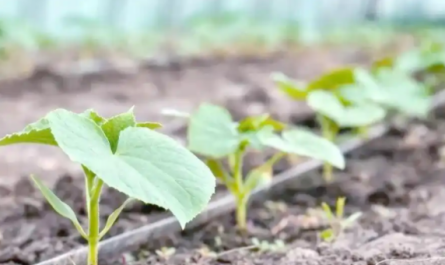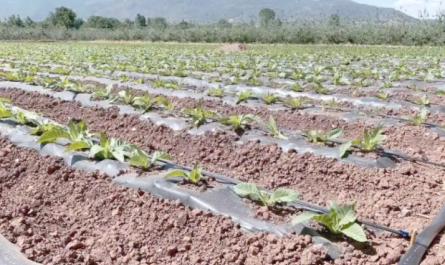The effects of temperature difference on plant growth are dual
The effects of temperature difference on plant growth are dual: A moderate diurnal temperature range (typically 8-10°C) promotes plant growth and improves quality; however, excessive temperature differences or extreme changes can inhibit growth or even cause damage. This effect stems from the balance between photosynthesis and respiration, and varies depending on the plant type and growth stage.

Benefits of Moderate Temperature Difference: A moderate diurnal temperature range significantly promotes plant growth and improves quality by optimizing photosynthesis and respiration:
1. Promotes organic matter accumulation:
Higher daytime temperatures enhance photosynthesis, synthesizing more organic matter; lower nighttime temperatures inhibit respiration, reducing consumption and thus increasing net accumulation, supporting growth and flowering.
2. Improves product quality:
In areas with large temperature differences (such as grape and apple producing regions), fruits have higher sugar content and flowers are more ornamental. 2.5
Regulating the growth cycle:
Affects seed germination, flower bud differentiation, and flowering and fruiting.
Negative effects of excessive temperature differences: When the temperature difference exceeds the plant's tolerance range, it can lead to growth inhibition or physiological damage.
1. Slowed or Stagnant Growth:
Excessively low nighttime temperatures may cause plants to enter a semi-dormant state, resulting in delayed new shoot development and discoloration of branches and stems.
Cellular and Metabolic Damage:
Extreme temperature fluctuations disrupt enzyme activity, interfere with metabolic balance, and trigger frost damage or high-temperature stress, affecting water and nutrient absorption.
2. Increased Risk:
Sudden temperature changes can easily lead to fungal diseases or physical damage, such as leaf rot in succulents under sudden environmental changes.

In environments with large temperature differences, the following plant growth regulators can be used to help plants better adapt to environmental changes and improve crop yield and quality:
Gibberellic Acid (GA3):
GA3 is a broad-spectrum plant growth regulator that promotes plant cell elongation, increases plant height and leaf size. GA3 can also break the dormancy of seeds, tubers, and rhizomes, promoting their germination. Furthermore, GA3 can stimulate fruit growth, increase fruit set, or form seedless fruits. Under conditions of large temperature differences, gibberellic acid can help plants perform photosynthesis better, increasing crop yield.
Paclobutrazol:
Paclobutrazol (PP333) is a plant growth retardant that primarily inhibits new shoot growth by suppressing gibberellin synthesis. It controls shoot growth, promotes flowering, increases fruit set, and improves fruit quality. In environments with large temperature fluctuations, Paclobutrazol can regulate plant growth, making plants more robust and enhancing their resistance to stress and diseases.
Brassinolide:
Brassinolide (BR) is a natural plant growth regulator that promotes cell division and elongation, enhancing plant resistance to stress. In conditions with large temperature fluctuations, Brassinolide helps plants better adapt to environmental changes, improving crop yield and quality.

Benefits of Moderate Temperature Difference: A moderate diurnal temperature range significantly promotes plant growth and improves quality by optimizing photosynthesis and respiration:
1. Promotes organic matter accumulation:
Higher daytime temperatures enhance photosynthesis, synthesizing more organic matter; lower nighttime temperatures inhibit respiration, reducing consumption and thus increasing net accumulation, supporting growth and flowering.
2. Improves product quality:
In areas with large temperature differences (such as grape and apple producing regions), fruits have higher sugar content and flowers are more ornamental. 2.5
Regulating the growth cycle:
Affects seed germination, flower bud differentiation, and flowering and fruiting.
Negative effects of excessive temperature differences: When the temperature difference exceeds the plant's tolerance range, it can lead to growth inhibition or physiological damage.
1. Slowed or Stagnant Growth:
Excessively low nighttime temperatures may cause plants to enter a semi-dormant state, resulting in delayed new shoot development and discoloration of branches and stems.
Cellular and Metabolic Damage:
Extreme temperature fluctuations disrupt enzyme activity, interfere with metabolic balance, and trigger frost damage or high-temperature stress, affecting water and nutrient absorption.
2. Increased Risk:
Sudden temperature changes can easily lead to fungal diseases or physical damage, such as leaf rot in succulents under sudden environmental changes.

In environments with large temperature differences, the following plant growth regulators can be used to help plants better adapt to environmental changes and improve crop yield and quality:
Gibberellic Acid (GA3):
GA3 is a broad-spectrum plant growth regulator that promotes plant cell elongation, increases plant height and leaf size. GA3 can also break the dormancy of seeds, tubers, and rhizomes, promoting their germination. Furthermore, GA3 can stimulate fruit growth, increase fruit set, or form seedless fruits. Under conditions of large temperature differences, gibberellic acid can help plants perform photosynthesis better, increasing crop yield.
Paclobutrazol:
Paclobutrazol (PP333) is a plant growth retardant that primarily inhibits new shoot growth by suppressing gibberellin synthesis. It controls shoot growth, promotes flowering, increases fruit set, and improves fruit quality. In environments with large temperature fluctuations, Paclobutrazol can regulate plant growth, making plants more robust and enhancing their resistance to stress and diseases.
Brassinolide:
Brassinolide (BR) is a natural plant growth regulator that promotes cell division and elongation, enhancing plant resistance to stress. In conditions with large temperature fluctuations, Brassinolide helps plants better adapt to environmental changes, improving crop yield and quality.
RECENT POSTS
Featured News



